Orthodontics is a branch of dentistry that deals with the treatment of irregularities of teeth and abnormalities in their relationship with the surrounding structures.
The factors that influence the uptake of orthodontic treatment are reviewed with respective features and aspirations of the consumers (patients and parents) and the provider (dentist, orthodontists and health system). It appears that the assessment of orthodontic treatment need is influenced by many variables which relate to opportunity and demand for treatment; this results in a marked lack of uniformity in treatment uptake [2].
A malocclusion is not an acute condition which requires urgent relief; instead, it is a variation from normal, which may or may not predispose to a disease or impairment.
The deleterious effects of malocclusion on the health of masticatory system are unclear. Occlusal anomalies are considered to be deviations from normal, rather than diseases. Therefore, the main criteria for delivery of orthodontic treatment is poor dental aesthetics, which is a direct consequence of occlusal irregularities. Aesthetics is the common reason for seeking orthodontic treatment and its improvement is an essential treatment goal [3].
Epidemiological and clinical orthodontic indices were developed, in order to standardize the assessment of orthodontic care. Considerable numbers of clinicians are using these indices in their daily practices [4].
These occlusal indices are useful for research, audit, practice management, and quality assurance in orthodontics. Over the years, different indices were developed for various facets of orthodontic provision, but they could not enjoy international acceptance. This contributed in making international comparison of data difficult [5].
The IOTN and ICON can be applied directly to patients.
The aim of the present study was to assess the need of orthodontic treatment by using Index of Orthodontic Treatment Need (IOTN) and Index of Complexity Outcome and Need (ICON), among school children who were aged 12-16 years /6th to 10th standard in Raichur, district of north Karnataka, India, a diversified population.
Methodology
Study population: This study was conducted over a period of 6 months.
This study was conducted on school children who were aged 12-16 years. It was given an ethical clearance by ethical committee of A.M.E’s Dental College, Raichur, India. A simple random selection of 1000 school children who studied in classes 6th to class 10th, was done. Students who were undergoing orthodontic treatment, and those who had any congenital abnormalities, were excluded from this study.
The examination was made with patient in the knee to knee position, by using disposable (gloves, dental mirrors, and IOTN-DHC) rulers under natural daylight.
The Index of orthodontic treatment needs (IOTN) [
2]
This index incorporates aesthetic and dental health components.
The aesthetic component consists of a scale which includes 10 colour photographs [Table/Fig-1] which show different levels of dental attractiveness in various malocclusions. The dental attractiveness of prospective patients can be rated with reference to this scale. First photograph represents the most attractive arrangements of teeth and 10th photograph represents the least attractivearrangements. The score reflects the aesthetic impairment.
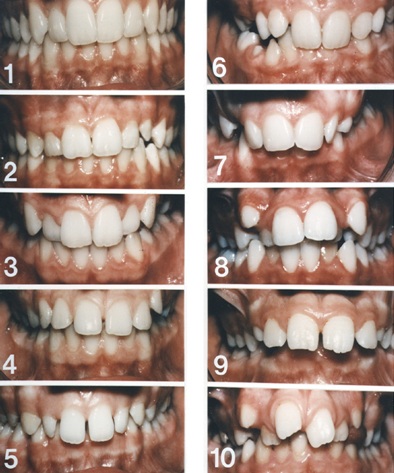
Dental health component
It was developed to reduce subjectively in measurement with well defined cut off points. The DHC records the various occlusal traits of a malocclusion, that would increase the morbidity of the dentition and surrounding structures. There are 5 grades, grades 1 -‘no need for treatment’ to grades 4 and 5- ‘needing treatment’. A severe over jet of greater than 9mm would fall into grade 5. Displacements which occur between contacts points which are less than 1mm would fall into grade 1. Importantly, only the worst occlusal feature is recorded [Table/Fig-2].
| Grade 5 (Very Great) | 5.a Increased overjet> 9 mm 5.h Extensive hypodontia with restorative implications (more than one tooth missing in any quadrant requiring pre-restorative orthodontics) 5.i Impeded eruption of teeth (apart from 3rd molars) due to crowding, displacement, the presence of supernumerary teeth, retained deciduous teeth, and any pathological cause 5.m Reverse overjet> 3.5 mm with reported masticatory and speech difficulties 5.p Defects of cleft lip and palate 5.s Submerged deciduous teeth |
| Grade 4 (Great) | 4.a Increased overjet> 6mm but <= 9 mm 4.b Reverse overjet> 3.5 mm with no masticatory or speech difficulties 4.c Anterior or posterior crossbites with > 2 mm discrepancy between the retruded contact position and intercuspal position 4.d Severe displacements of teeth > 4 mm 4.e Extreme lateral or anterior open bites > 4 mm 4.f Increased and complete overbite with gingival or palatal trauma 4.h Less extensive hypodontia requiring pre-restorative orthodontics or orthodontic space closure to obviate the need for a prosthesis 4.l Posterior lingual crossbite with no functional occlusal contact in one or more buccal segments 4.m Reverse overjet> 1 mm but < 3.5 mm with recorded masticatory and speech difficulties 4.t Partially erupted teeth, tipped and impacted against adjacent teeth. 4.x Existing supernumerary teeth |
| Grade 3 (Moderate) | 3.a Increased overjet> 3.5 mm but <= 6 mm (incompetent lips) 3.b Reverse overjet greater than 1 mm but <= 3.5mm 3.c Anterior or posterior crossbiteswitt>1mm but <= 2mm discrepancy between the retruded contact position and intercuspal position 3.d Displacement of teeth >2mm but <=4mm 3.eLlateral or anterior open bite > 2mm but <= 4mm 3.f Increased and incomplete overbite without gingival or palatal trauma |
| Grade 2 (LITTLE) | 2.a Increased Overjet> 3.5 mm but <= 6 mm (with competent lips) 2.b Reverse overjet greater than 0 mm but <= 1mm 2.c Anterior or posterior crossbite with <= 1mm discrepancy between retruded contact position and intercuspal position 2.d Displacement of teeth > 1mm but <= 2mm 2.e Anterior or posterior open bite > 1mm but <= 2mm 2.f Increased overbite >= 3.5mm (without gingival contact) 2.g Prenormal or postnormal occlusions with no other anomalies. Includes up to half a unit discrepancy |
| Grade1 (NONE) | 1. Extremely minor malocculsions, including displacements less than 1 mm |
To help in identifying the worst occlusal feature,
The hierarchical scale which was used was as follows:
Missing teeth (including congenital absence, ectopically erupted and impacted teeth)
Overjets (including reverse overjets).
Crossbites.
Displacement of contact points.
Overbites (including open bites).
The acronym “MOCDO” can be constructed from the first letter of each category.
The dental health component ruler
A ruler has been designed, which contains all the information which is necessary to record the DHC [Table/Fig-3]. The ruler was developed for clinical settings in which information was collected, regarding lip competence, displacement on closure and masticatory/ speech problems. Only the worst occlusal features were recorded.
Dental health component ruler (hierarchical scale)
| 0 | 3 i | 4 | 5 | 5 Defect of CLP 5 Non eruption of teeth 5 Extensive hypodontia 4 Less extensive hypondontia 4 Crossbite >2 mm discrepancy 4 Scissors bite 4 O.B. with G + P trauma | 3 O.B. with NO G + P trauma 3 crossable 1-2 mm discrepancy 2 O.B. > ------ 2 Dev. From full interdig 2 Crossible < 1 mm discrepancy @iotn victoria university of manchester | displacement open bite V  4 3 2 1 4 3 2 1 |
| 2 | 2 c |
| 3 | 4-ms -5 |
| 4 |
There are two ways of recording DHC. The first is to record the grade only; in the second, an initiating feature would be recorded, for example, an overjet which is greater than 9mm would be 5a (the grade being 5 and the overjet being signified by letter). The second method provides more information regarding the prevalence of the specific occlusal traits [2].
Index of complexity, outcome, and need (ICON) index [
7]
This index has 5 components, all of which were scored as per the method which has been described below [Table/Fig-4]:
| Score | 0 | 1 | 2 | 3 | 4 | 5 | weight |
|---|
| Aesthetic component | 1 2 | 3 4 | 5 | 6 7 | 8 9 | 10 | 7x9 = 63 7x2 = 14 |
| Upper arch crowding | Less than 2 mm | 2.1 – 5 mm | 5.1 to 9 mm | 9.1 to 13 mm | 13.1 to 17 mm | >17 mm or | 5x3=15 5x0=0 |
| Upper arch spacing | Up to 2 mm | 2.1 – 5 mm | 5.1 to 9 mm | >9 mm | | impacted teeth | |
| Crossbite | No | yes | | | | | |
| Incisor open bite | Edge to edge | <1mm | 1.1-2mm | 2.1-4mm | >4mm | | |
| Incisor overbite | Up to 1/3 incisal coverage | 1/3 – 2/3 coverage | 2/3 up to full coverage | Full coverage | | | 4x3=12 4x0=0 |
| Sagittal relationship of the buccal segment | Cusp to embrasure relationship only, Class I, II or III | Any cusp relation up to but not including cusp to cusp | Cusp to cusp relationship | | | | L 3X2=6 R 3X2=6 L 3X1=3 R 3X1=3 |
Dental aesthetics: For assessing the dental aesthetics, the dental aesthetic component which was adopted from the IOTN index was used. Once the score was obtained, it was multiplied by the weighting of 7.
Upper arch crowding/ spacing: The sum of the mesio-distal widths of the crowns was compared with the arch circumference, which was mesial to the last standing tooth, on either side. A divider and mm ruler were used after working out the crowding or spacing in mm. In transitional dentition, to assess the widths of the unerupted canines and premolars, the widths of the erupted antimeric teeth were considered. In case of their absence, an average of premolars and lower canines and for upper canine was considered. Once the score was obtained, it was multiplied by the weighting of 5.
A normal transverse relationship in the buccal segments was considered. When a crossbite was present in the posterior or anterior segments or both, the raw score of 1 was given, which was multiplied by the weighting of 5. In absence of this trait, it was scored as 0.
Anterior vertical relationship: This trait included both open bite and deep bite. The highest scoring raw score was counted in cases where both traits were present. The raw score was multiplied with a weighting of 4.
Buccal segment antero-posterior relationship: The scoring zone included the canines, premolars and molar teeth. The antero-posterior cuspal relationship was scored according to the protocol which was given for each side, in turn. The raw scores for both sides were added together and then multiplied by weighting of 3.
These raw scores were multiplied by the respective weights to obtain a weighted score. The sum of weighted score was the ICON score for the case. Pre-treatment score gave the treatment need and complexity grades. Post-treatment scores indicated the treatment outcome. Four times the post-treatment score, which was subtracted from pre-treatment score, gave the degree of improvement [Table/Fig-4].
Validation
All five components are assessed according to the protocols which have been outlined in [Table/Fig-2]. The derived scores are then multiplied by their respective weights and summed. Treatment needs for dental health component (DHC) and aesthetic component (AC) of the IOTN, and for the ICON, were defined according to the categories of scores which have been given in [Table/Fig-4].
Statistical Analysis
1.Chi-square test was used to compare between the study and control groups and also to assess the gender difference.
2. Kappa statistics was calculated to find the agreement between the subjects and the orthodontist.
Results
The distributions of normative orthodontic treatment needs, as was assessed by AC of IOTN, has been shown in [Table/Fig-5], as was assessed by the DHC of IOTN, has been shown in [Table/Fig-6] and as was assessed by the ICON, has been shown in [Table/Fig-7]. The p-values which were obtained, indicated that all the comparisons were “Fairly” statistically significant for gender differences. The age group was also compared for differences in age. The p-value which was obtained, indicated that the aesthetic component showed no significant outcome and that the dental health component, the index of complexity outcome and need component showed that outcomes which were obtained were highly significant.
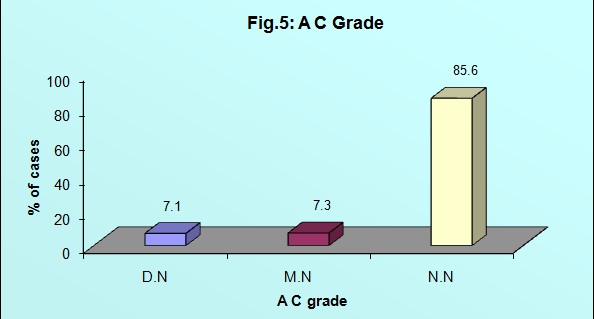
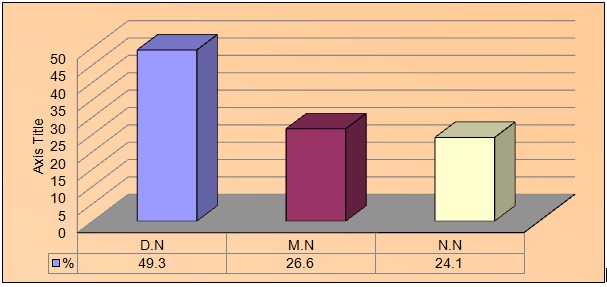
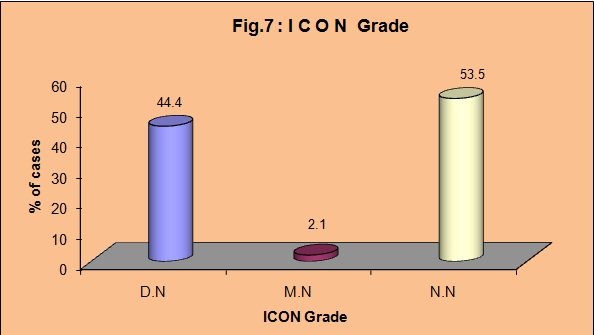
Characteristics survey population with respect to gender has been summarized in [Table/Fig-8]. The response rate concerning knowledge and interest in orthodontic treatment has been shown in [Table/Fig-9].The distribution of DHC grade and qualifier of the sample have been explained in [Table/Fig-10], which summarized that impacted teeth were most commonly found.
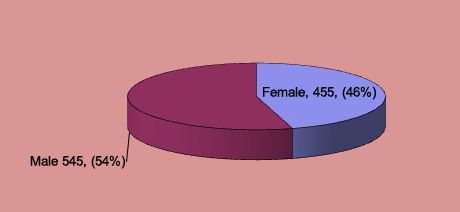
Knowledge of orthodontic treatment need
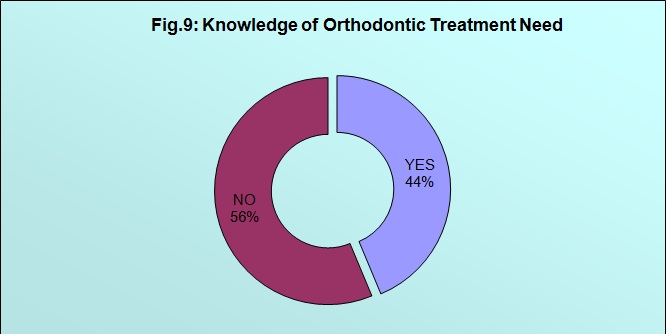
Distribution of DHC grades and qualifiers of total sample
| DHC grades and Qualifiers |
|---|
| No. | % |
| 1.a | 81 | 8.1 |
| 2.a | 143 | 14.3 |
| 2.a,f | 1 | 0.1 |
| 3,a,e | 1 | 0.1 |
| 3,a,f | 1 | 0.1 |
| 3.a | 111 | 11.1 |
| 3.a,c | 5 | 0.5 |
| 3.a,c,f | 2 | 0.2 |
| 3.a,e | 3 | 0.3 |
| 3.a,f | 33 | 3.3 |
| 3.c | 36 | 3.6 |
| 3.c,a | 4 | 0.4 |
| 3.c,f | 5 | 0.5 |
| 3.e | 16 | 1.6 |
| 3.e,a | 1 | 0.1 |
| 3.e,c | 1 | 0.1 |
| 3.f | 42 | 4.2 |
| 3.f,a | 3 | 0.3 |
| 4.a | 49 | 4.9 |
| 4.a,c | 3 | 0.3 |
| 4.a,f | 21 | 2.1 |
| 4.b | 1 | 0.1 |
| 4.c | 35 | 3.5 |
| 4.c,a | 1 | 0.1 |
| 4.c,e | 2 | 0.2 |
| 4.c,f | 1 | 0.1 |
| 4.e | 10 | 1 |
| 4.f | 48 | 4.8 |
| 4.f,a | 7 | 0.7 |
| 4.f,c | 1 | 0.1 |
| 4.l | 2 | 0.2 |
| 5.a | 7 | 0.7 |
| 5.a,f | 2 | 0.2 |
| 5.c | 1 | 0.1 |
| 5.f | 1 | 0.1 |
| 5.i | 273 | 27.3 |
| 5.I | 1 | 0.1 |
| 5.i, c,f | 1 | 0.1 |
| 5.i,a,c | 1 | 0.1 |
| 5.i,a,f | 2 | 0.2 |
| 5.i,c | 7 | 0.7 |
| 5.i,c,f | 2 | 0.2 |
| 5.i,e | 1 | 0.1 |
| 5.i,f | 29 | 2.9 |
| 5.i,F | 1 | 0.1 |
| 5.i,f,c | 1 | 0.1 |
| Total | 1000 | 100 |
DHC indicates dental component of Index of Orthodontic Treatment Need; i=impacted teeth, h= missing tooth, a= overjet, m= reverse overjet with reported masticatory or speech difficulties, b= reverse overjet without reported masticatory or speech difficulties, p= defects of cleft lip and palate, s= submerged deciduous tooth, e= open bite, l= posterior cross bite with no occlusa l contacts in one or both buccal segment, c= other crossbite, d= displacement of contact point, f= overbite, t= impacted tooth, x= presence of supernumerary tooth
Discussion
Most of the studies have assessed dental caries, periodontal disease and malocclusion prevalence, but not the orthodontic treatment need.
Our estimates of orthodontic treatment need, as were assessed by the DHC of the IOTN (49.3%) [Table/Fig-6] and by the ICON (44.4%) [Table/Fig-7] exceeded those which were reported in Turkish (38.8%), Irish (30.4%), Kuwaiti (28%) [6], and Malaysian schoolchildren (47.9%), but they were below those which were reported in Singaporean adult male recruits (50.1%) [8]. However, the treatment needed in the latter study was assessed by making study cast measurements. In such cases, some malocclusion-related complications such as incompetent lips, functional mandibular shifts, and masticatory and speech difficulties were assumed to be present, even though they may have been clinically absent. Available African studies which used the IOTN reported much lower prevalences among Nigerian children (13%) [9] and Tanzanian children (22%) [10].
To the best of our knowledge, there is only one survey which was done on orthodontic treatment need by using ICON, and in that study, which involved 505 school children who were aged 12–13 years, Liepa et al., found 35.3% to be in definite need of orthodontic treatment.
Also, this prevalence rate was higher than that which was reported by Diagne et al., in Senegalese school children (32.61%), but this could have resulted from differences in the indices which were used, rather than from an epidemiological transition. A close analysis done, of the distribution of DHC grades and qualifiers in the total sample, showed that contact point displacement was the most commonly found occlusal trait (39.9%) in the definite-need group, followed by dental crossbites. These findings could have public dental health implications, because crowding was the occlusal trait which is most commonly associated with a poor periodontal condition and crossbite, with gingival recession [11]. Professional assessment of treatment need by using AC of the IOTN, classified only 7.1% [Table/Fig-5] of the sample as being in definite need of orthodontic treatment. These figures were comparable to those which were reported in other African surveys by using the IOTN. For instance, Otuyemi et al., and Mugonzibwa et al., [9] found that 7% and 11% of Nigerian and Tanzanian children were in definite need of orthodontic treatments, on the basis of the AC component. On the other hand, greater rates of AC grades of 8–10 were reported for other racial groups. The high discrepancy between treatment needs, as was indicated by the AC and DHC of the IOTN and the ICON, may have occurred because of the fact that malocclusional traits such as missing teeth and crossbites of posterior teeth did not always make aesthetic impacts.
For assessing knowledge on and demand for orthodontic treatment, the question “Have you ever seen anyone with braces or heard about a treatment for straightening teeth?” [Table/Fig-9] was asked, which elicted 563 negative responses (56.3%). On the other hand, 437 gave positive responses (43.7) that they had heard of treatment for straightening their teeth. It appeared from this and earlier studies, that there was a common perception on orthodontic aesthetics. This commonality may be present for specific occlusal traits, and cultural and socio-economical background could also influence a subject’s judgement [12]. In the case of professional assessment of orthodontic treatment need, there were no gender differences in the subjective perception of treatment need. Conflicting results had long been reported with respect to the influence of sex on both normative and perceived needs for orthodontic treatment. For instance, Kerosuo et al., and Esa et al., found higher normative treatment needs for males than for females, but higher needs have been reported for females than for male subjects by Burden et al., [13] and Tuominen et al., [14].
The subject perception of their dental appearances was of considerable importance in determining both treatment demand and the subsequent level of co-operation during treatment. It was suggested that subjects of 11-19 years age group were capable of making objective aesthetic evaluations of their teeth, but that there was a broad range of what was considered to be acceptable for their subjects [15].
Assessment of an aesthetic need, for undergoing an orthodontic treatment is complex, and this was clearly seen in the differences in opinion between professional persons and the subjects. Some children found the concept behind the aesthetic component difficult to grasp. Children constantly attempted to match their dentitions with the photographs, looking for specific morphological traits. This was especially true for children with fractured incisors and bilateral, congenitally absent or peg- shaped lateral incisors, all of whom found the selection of photographs which best represented their degrees of dental attractiveness difficult [16].
In terms of treatment need, males were found to have a higher level of subjective treatment need and demand [Table/Fig-8]. This study, being contradictory to the earlier studies done by Roberts et al., and Holmes, concluded that females had higher levels of subjective treatment treatment needs and demands [Table/Fig-11,12and13]. However, our study reports were similar to those of the studies which were conducted by Brown et al., and Otuyem’s et al., who concluded that males were more likely to seek orthodontic treatment [9].
Comparision of aesthetic component between males and
| Sex * ACGrade |
|---|
| Sex | | ACGrade | Total |
| D.N | M.N | N.N |
| F | No. | 25 | 29 | 401 | 455 |
| % | 5.5% | 6.4% | 88.1% | 100.0% |
| M | No. | 46 | 44 | 455 | 545 |
| % | 8.4% | 8.1% | 83.5% | 100.0% |
| Total | No. | 71 | 73 | 856 | 1000 |
| % | 7.1% | 7.3% | 85.6% | 100.0% |
| Chi-Square | df | p-value |
| 4.64 | 2 | 0.10 |
Comparision of dental health component between males and females
| Sex * DHC Grade |
|---|
| Sex | | DHC Grade | Total |
| D.N | M.N | N.N |
| F | No. | 212 | 124 | 119 | 455 |
| % | 46.6% | 27.3% | 26.2% | 100.0% |
| M | No. | 281 | 142 | 122 | 545 |
| % | 51.6% | 26.1% | 22.4% | 100.0% |
| Total | No. | 493 | 266 | 241 | 1000 |
| % | 49.3% | 26.6% | 24.1% | 100.0% |
| Chi-Square | df | p-value |
| 2.84 | 2 | 0.24 |
Comparision of index of complexity, outcome and treatment need between males and females
| Sex * ICONGrade |
|---|
| Sex | | ICON Grade | Total |
| D.N | M.N | N.N |
| F | No. | 196 | 8 | 251 | 455 |
| % | 43.1% | 1.8% | 55.2% | 100.0% |
| M | No. | 248 | 13 | 284 | 545 |
| % | 45.5% | 2.4% | 52.1% | 100.0% |
| Total | No. | 444 | 21 | 535 | 1000 |
| % | 44.4% | 2.1% | 53.5% | 100.0% |
| Chi-Square | df | p-value |
| 1.23 | 2 | 0.54 |
To assess the agreement between the orthodontists and the subjects, Kappa statistics was calculated. The obtained Kappa value suggested there was a “fair” agreement between them.
The values weighted Kappa coefficient for IOTN both AC (0.25) and DHC (0.35) represent very high intraexaminer reliability. The AC had lower reliability as compared to DHC, but it belonged to the same high category, according to interpretation of Landis and Koch [17]. In a study done by Beglin et al., the kappa coefficients were found to be 0.93 AC and 0.93 DHC, with good inter examiner reliability [18].
In these studies, the reliabilities were found to be higher as compared to those seen in our study. Possible explanations for the lower reliability of the aesthetic component may be the facts that it was not universally accepted in orthodontic profession and that there were disagreements on the sequences of 10 photographs. Secondly, may be the examiner was not trained in the use of IOTN, but had followed the procedure which had been described in the literature [19].
It was previously suggested that ICON could replace PAR and IOTN as an indicator of outcome and need. It was true that ICON can be used to measure outcome, need, and complexity from a single index, and our results suggested that, with respect to treatment need, if a borderline need (IOTN DHC grade 3 and IOTN AC grade 5-7) was included, ICON could indeed replace IOTN [20].
The mean ICON score which was recorded in this study was expectedly lower than those -67.38±19.63 (SD), 72.5, 69, 72.9±13 (SD) which had reported in previous clinic-based studies done in Nigeria, Sweden, Greece and UK. Meanwhile, the mean ICON score recorded for Riga and Daugavpils secondary school children in Latvia had been reported in a similar epidemiological study [21].
Conclusion
In terms of treatment need, males were found to have higher levels of subjective treatment needs and demands than females. There was a “fair” agreement between the subjects and the orthodontists.The knowledge on the orthodontic treatment need was only 44%. The need of orthodontic treatment far exceeded the actual supply which was available.
DHC indicates dental component of Index of Orthodontic Treatment Need; i=impacted teeth, h= missing tooth, a= overjet, m= reverse overjet with reported masticatory or speech difficulties, b= reverse overjet without reported masticatory or speech difficulties, p= defects of cleft lip and palate, s= submerged deciduous tooth, e= open bite, l= posterior cross bite with no occlusa l contacts in one or both buccal segment, c= other crossbite, d= displacement of contact point, f= overbite, t= impacted tooth, x= presence of supernumerary tooth